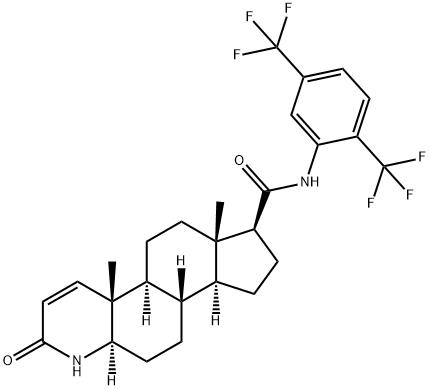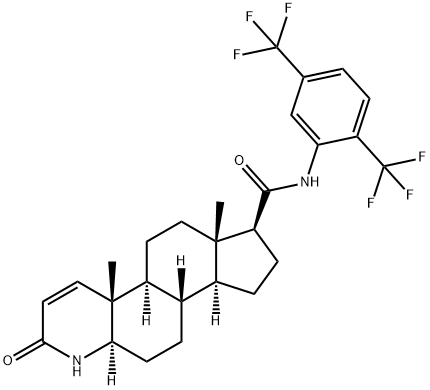Dutasteride: Recent advances and clinical applications in the treatment of prostate diseases and alopecia
Sep 18,2024
Introduction
Dutasteride, a new second-generation 5α-reductase inhibitor, has shown significant efficacy in the treatment of benign prostatic hyperplasia (BPH) since it was approved by the U.S. Food and Drug Administration in 2002. In recent years, with the deepening of research, the potential of dutasteride in the treatment of male pattern alopecia, seborrheic alopecia, and hereditary alopecia has been gradually revealed. The purpose of this paper is to comprehensively review its chemical properties, pharmacological effects, clinical applications, safety, and side effects, in order to provide references for clinicians and researchers.1
Chemical characteristics and pharmacological effects
Chemical Characteristics
Dutasteride, molecular formula C27H30F6N2O2, molecular weight 528.53. It is a white crystalline solid with a density of 1.303 g/cm³, a melting point of 242-250°C, and insoluble in water, but soluble in organic solvents such as ethanol, methanol, and polyethylene glycol.

Pharmacological Effects
Dutasteride is a relatively specific 5α-reductase inhibitor that can inhibit both type I and type II 5α-reductase isoenzymes. Testosterone is converted to dihydrotestosterone (DHT) under the action of 5α-reductase, and DHT is a key factor in promoting prostate growth and development. By inhibiting these two isoenzymes, dutasteride reduces the conversion of testosterone to DHT, thereby reducing DHT levels, which in turn inhibits the growth and development of the prostate. In addition, DHT is also one of the major pathogens that cause androgenetic alopecia, so it also shows potential in the treatment of hair loss.

Clinical application
Benign prostatic hyperplasia (BPH)
Dutasteride is one of the main drugs in the treatment of BPH. It can effectively improve the symptoms of BPH patients, such as frequent urination, urgent urination, increased nocturnal urination, dysuria, etc., and reduce the risk of acute urinary retention (AUR) and surgery. One study showed that dutasteride was able to significantly reduce prostate volume, improve urine flow rates, and improve patient's quality of life in the treatment of moderate to severe BPH. In addition, it can reduce the incidence of prostate cancer and provide more comprehensive protection for BPH patients.
Androgenetic alopecia (AGA)
Although dutasteride was once delayed in clinical trials to treat hair loss, its potential has come to the forefront in recent years. DHT is one of the main pathogens that cause AGA. By inhibiting the production of DHT, Dutasteride can slow down hair follicle atrophy and promote hair regeneration. A clinical trial in patients with AGA showed that it was able to significantly improve hair loss symptoms in patients, increasing hair density and diameter. However, it is important to note that the safety in the treatment of hair loss has not been fully established and is contraindicated in women and children.
Other Applications
In addition to BPH and AGA, dutasteride may have a role in other areas. For example, studies have shown that it can inhibit the growth and spread of prostate cancer cells, providing a new idea for the treatment of prostate cancer. In addition, it may also have potential in the treatment of androgenic alopecia, hirsutism, etc., but further clinical studies are needed to verify its efficacy and safety.2
Future prospects
New progress in the treatment of hair loss
Preliminary studies have shown that dutasteride has significant potential in the treatment of AGA. Since DHT is a key factor in AGA, Dutasteride can slow down hair follicle atrophy and promote hair regeneration by inhibiting DHT production. In the future, with the development of more clinical trials and in-depth research, the efficacy and safety in the treatment of hair loss will be further verified and may become one of the important drugs for the treatment of AGA.
Prevention and treatment of prostate cancer
In addition to treating BPH, dutasteride may also play an important role in the prevention and treatment of prostate cancer. Some studies have shown that it can reduce the incidence of prostate cancer, which may be related to inhibiting DHT levels and slowing the proliferation of prostate cells. In addition, it may be used in combination with other chemotherapy drugs to improve the treatment effect of prostate cancer. In the future, with an in-depth understanding of the pathogenesis and treatment methods of prostate cancer, the application prospects in the field of prostate cancer will be broader.3
Innovation of drug dosage forms
In order to improve the efficacy and patient compliance of dutasteride, more novel drug dosage forms may be developed in the future. For example, developing formulations with longer half-lives or better bioavailability to reduce the number of dosing times and doses; Developing new drug delivery methods such as transdermal patches or oral dissolving tablets to improve the convenience and comfort of patients. These innovations will help better meet the treatment needs of patients.4
Application of personalized medicine
With the development of precision medicine and personalized medicine, the use of dutasteride may also be more personalized in the future. By combining factors such as a patient's genotype, disease severity, and treatment response, doctors can develop more precise treatment plans to improve treatment effectiveness and reduce side effects. In addition, by monitoring patients' serum DHT levels and related biomarker changes, doctors can also adjust the treatment regimen in time to ensure that patients get the best treatment results.
Conclusion
Dutasteride, as a novel second-generation 5α-reductase inhibitor, has shown remarkable efficacy in the treatment of benign prostatic hyperplasia (BPH) and androgenetic alopecia (AGA). By inhibiting the production of DHT, it can slow down the proliferation of prostate cells and atrophy of hair follicles, thereby improving the symptoms and quality of life of patients. Although there may be some side effects and drug interactions during use, these risks can be effectively controlled through reasonable medication guidance and monitoring measures. In the future, with the continuous deepening of the research on dutasteride and the innovation of drug dosage forms, its clinical application range and efficacy will be further expanded and improved. At the same time, the development of personalized medicine will also provide strong support for the precision treatment of dutasteride.5
References:
[1] Dutasteride[J]. Reactions Weekly, 2018, 10 1. DOI:10.1007/s40278-018-55300-4.
[2] NEIL E FLESHNER. Dutasteride in localised prostate cancer management: the REDEEM randomised, double-blind, placebo-controlled trial.[J]. The Lancet, 2012, 379 9821. DOI:10.1016/S0140-6736(11)61619-X.
[3] SUSAN J KEAM L J S. Dutasteride: a review of its use in the management of prostate disorders.[J]. Drugs, 2008, 68 4. DOI:10.2165/00003495-200868040-00008.
[4] TASLEEM ARIF. Dutasteride in Androgenetic Alopecia: An Update.[J]. Current clinical pharmacology, 2017. DOI:10.2174/1574884712666170310111125.
[5] ELISE A. OLSEN MD . The importance of dual 5α-reductase inhibition in the treatment of male pattern hair loss: Results of a randomized placebo-controlled study of dutasteride versus finasteride[J]. Journal of the American Academy of Dermatology, 2006, 55 6: 929-1158. DOI:10.1016/j.jaad.2006.05.007.
- Related articles
- Related Qustion
1,7-Dimethylxanthine is a naturally occurring alkaloid compound that can enhance alertness and reduce drowsiness.....
Feb 27,2025API1-Benzyl-4-piperidone is crucial in creating menin inhibitors for treating MLL fusion-related leukemia, with efficient synthesis methods enhancing its industrial and therapeutic applications.....
Sep 18,2024APIDutasteride
164656-23-9You may like
- Oral Dutasteride Avodart
-

- $0.00 / 25KG
- 2025-03-21
- CAS:164656-23-9
- Min. Order: 1KG
- Purity: 99%
- Supply Ability: 50000KG/month
- Dutasteride
-

- $0.00 / 25KG
- 2025-03-21
- CAS:164656-23-9
- Min. Order: 1KG
- Purity: 99%
- Supply Ability: 20TON
- Dutasteride
-

- $5.00 / 1Box
- 2025-03-21
- CAS:164656-23-9
- Min. Order: 1Box
- Purity: 99.99%
- Supply Ability: 20000 boxes






